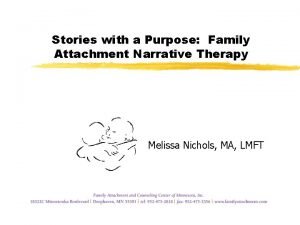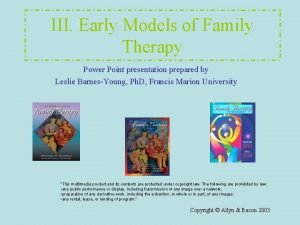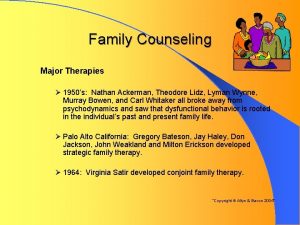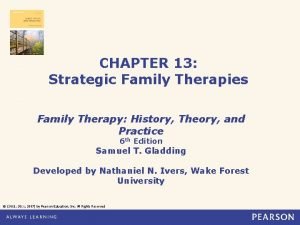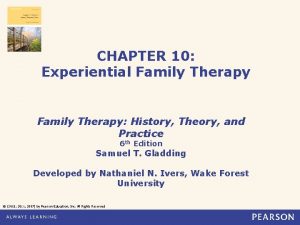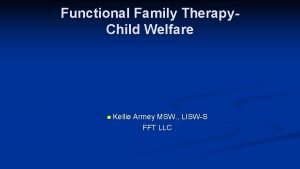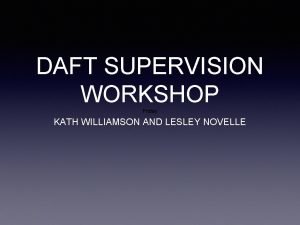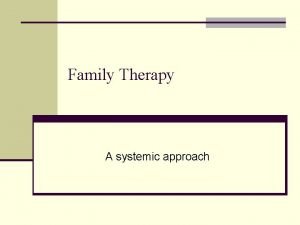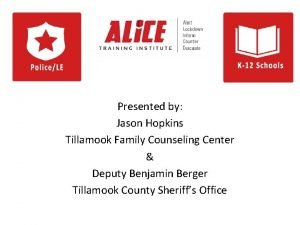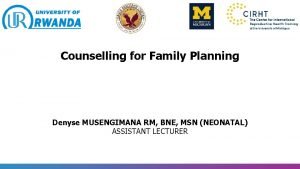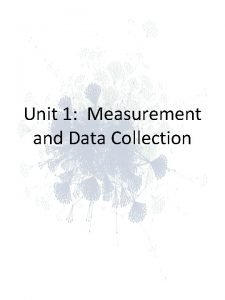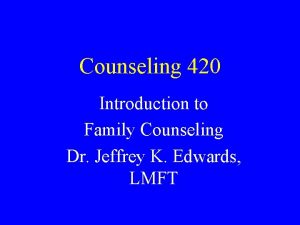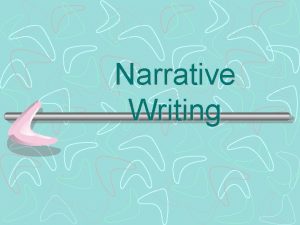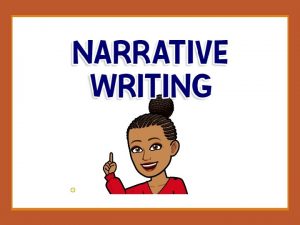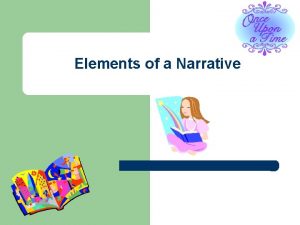Narrative Therapy Counseling 420 Introduction to Family Counseling

































- Slides: 33

Narrative Therapy Counseling 420, Introduction to Family Counseling. Dr. Jeffrey K Edwards. Northeastern Illinois University. Chicago, IL The Wolf and Little Red. A postmodern story.

"The Maligned Wolf" § Well, to begin at the beginning, you see, I'm really not the person you see here - I'm really a wolf; not any kind of special wolf, just a regular wolf who was, on that fateful day long ago, trying to be a good wolf. The forest was my home. I lived there and since it was my home, I cared about it. I tried to keep it neat and clean, safe; you know - all those good things about the balance of nature and all. It happened one sunny day while I was going about my business in the forest (let's see, I was cleaning up some debris which a camper had left from the previous day) when I heard the sound of footsteps. I leaped behind a tree and saw a rather plain little girl coming down the trail carrying a basket. Now, since my job is to keep the forest safe and clean and neat, it is important that I know what's going on in the forest - to keep undesirables out, and to make sure that my home remains a fit place for me and all my friends to live.

§ I was suspicious of this little girl right away because aside from the basket she was carrying (which could hold all sorts of things) she was dressed funny -all in red and with her head covered so as to seem like she didn't want people to know who she was. So, naturally I stopped to check her out. I asked who she was, where she was going, where she had come from, why she was traveling, and whatever. She gave me song and dance about going to her grandmother's house and that suspicious looking basket contained lunch. I didn't believe her at first, but as I listened further, she appeared to be a basically honest person, and harmless. But she was in my forest and she certainly looked suspicious with that strange getup of hers, and I was worried that having her prancing down the path looking like that might scare my friends and might even tempt a forest creature not as responsible and kind as I, to threaten her, thus threatening the safety of my forest. So I decided to teach her a lesson so she might learn how serious it is to prance (skipping, I think she called it) through the forest unannounced and dressed funny.

§ I let her go on her way, and ran ahead to her grandmother's house and when I saw the nice old woman, I explained my problem. Being a forest creature herself, seeing as she lived in a small clearing on the edge of the forest, she agreed that her granddaughter needed to learn a lesson which, obviously, the girl's mother, who was the grandmother's daughter, had failed to teach. The old woman agreed to stay out of sight until I called her. Actually, she hid under the bed. § When the girl came to the door, I invited her into the bedroom where I was in bed dressed like the grandmother. The girl came in all rosy checked and said something nasty about my big ears (which she had no business doing since I can't do anything about my ears any more than you can). Anyway, I've been insulted before so I took the hurt and made the best of it by suggesting that my big ears would help me to hear better. Now, I thought that was a neat thing to say in response to her insult because I thought it meant I liked her and wanted to pay close attention to what she was saying.

§ But what does she do? She makes another insulting crack about my bulging eyes. Imagine! Here's a little girl who thought she was talking to her beloved grandmother and she makes two insulting cracks in a row! And after I tried to be nice when she insulted me the first time. Now you see how I was beginning to feel about this girl who had put on such a nice front, but apparently was a very nasty little person. I was actually most concerned about the feelings of the grandmother who could hear all of these insults from under that very bed! But I've made it a policy to turn the other cheek so I told her that my big eyes helped me to see her better. Wouldn't you think that she would get the message that I'm not going to play her nasty put down game? §

Not her! My plan had been to talk with her for awhile and then carefully remove the grandmother clothing to show the girl that she simply must be more careful and alert. But her next insult got to me. I've got this problem with my teeth. My parents were poor wolves and never had the money to have good dentistry done on me so I've got kind of prominent teeth. And that little brat made an insulting crack about my large teeth! Okay. I've tried to be nice all along, but I'm sensitive about my large teeth. And her insult about my large teeth made me very angry. I know that I should have had better control, but that's water under the bridge, as they say. Anyway, I leaped up from that insult and angrily growled that my teeth would help me to eat her better. Now, let's face it - no wolf could ever eat a little girl everyone knows that and besides, you know me well enough by now to know that I'd never hurt anything, It's just that I got very angry all of a sudden.

§ But that crazy little girl lost all touch with reality, She started running around screaming - me chasing her to calm her down - (I'd already taken off the grandmother clothes, but that only seemed to make it worse). The grandmother, incidentally, never came out to help me. All of a sudden the door came crashing down - some lumberjack destroyed the door with his ax as though there were a four alarm fire. I looked at him - and then at that hysterical little girl - and all of a sudden it became clear what I was into. The lumberjack thought I was attacking the girl. Well, I could understand his violent intentions then so I turned to him to explain and just then he swung his ax, splitting me open right across the middle. The blow was so hard that I flew across the room and landed on the other side of the bed. About that time the grandmother finally got it together and came out from under the bed. I lay there thinking that I ought not to make any sudden moves because there was that ax still in the lumberjack's hand, so I just lay still and they left the house, thinking that I was dying. The grandmother never did tell them what was going on there.

I've had a hard time forgiving her for that. But I didn't die, although I was pretty sick for a long time. And now people seem to think I'm a mean, nasty guy. I've had to change my appearance and my job. I'd much rather be a wolf and return to my forest, but I can't take that chance as long as there are so many people who think I'm dangerous. Why, even little children in school are taught that I'm mean and nasty. I've lost everything and just because I was trying to help, trying to keep my forest safe for everyone - even for that little girl. Well, now you know MY story, and I feel better already for telling you. It does seem to be better when I'm not carrying all those burdens by myself. Thank you for listening. Fearn, Lief. "The Maligned Wolf, " Individual Development: Creativity, Education Improvement Associated, San Diego, California, 1974.

How did you feel about (the wolf, Little Red, grandmother, the lumberjack) before the story? After? 2. At what point in the story did your perspective change? 3. At what point did your attitude about (the wolf, Little Red, grandmother, the lumberjack) change? 4. Do you agree or disagree with the title? Was the wolf maligned? Refer to the text to support your answer. 5. The wolf said he had a plan in mind when he dressed up like the grandmother. What was his plan? Use the text to support your answer. 6. Why did the wolf feel the little girl was threatening the forest? Do you think he just didn't want her in the forest because she looked, dressed and acted differently? 7. When do you think this new version was written? Why? (Recently? Focus on environment- 2 nd paragraph. ) 8. Do we as a society judge people on their dress? Examples? 9. To what conclusion did the lumberjack jump? 10. How does this story tie into the ways we perceive history as being written? 11. In a research paper, why do we go to more than one source? 1.

Faith vs. Belief “Belief is the insistence that the truth is what one would ‘lief’ or wish it to be. . . Faith. . . is an unreserved opening of the mind to the truth, whatever it may turn out to be. Faith has no preconceptions; it is a plunge into the unknown. Belief clings, but faith lets go. . . faith is the essential virtue of science, and likewise of any religion that is not selfdeception. ” – Alan Watts

The Talmud The highest form of wisdom is kindness.

Future Pull "You have to go fetch the future. It's not coming towards you, it's running away. " –Zulu proverb

Faith Take the first step in faith. You don't have to see the whole staircase, just take the first step. –Dr. Martin Luther King Jr.

Philosophical frameworks to ponder Postmodernism – Second Order Cybernetics Constructivism (radical and social) Epistemology – Narrative – Liberation philosophy -

§ Steinglass’s editorial on Family Therapy’s Future, (Family Process, 1996), reported that “Narrative approaches to family therapy have surely captured the imagination and interest in our field, reflected in the fact that manuscripts about these approaches represent the largest group of submissions to our journal these days. ” (p. ). “Within the short time span of five years, ” Nichols and Schwartz (2001) wrote, that “the narrative model dominates family therapy” (p. 387). Postmodern and Narrative psychotherapies have been evident in the field since the early 1980 s, as is evidenced by the famous Family Therapy Networker cover depicting Epistemology Man (1988), that heralded the news to all that there was a different breed of therapist practicing now.

§ Hallmarks of a postmodern /narrative therapy usually include a non pathologizing stance, the flattening of hierarchy, and a collaborative or coconstructed therapy experience, as opposed to the modernist, traditional medically modeled therapies (Edwards & Chen, 1999). To a postmodern/narrative therapist, the person isn’t the problem, the problem is, and they argue that “too often clients aren’t heard because therapists are doing therapy to them rather than with them” (Nichols and Schwartz, 2001, p. 205). In addition, modernist therapists are usually essentialists believing that there is a core to each human being, while postmodernists see people as evolving and changing according to the context with which they interact (Gergen, 2000 ).

Narrative- View of human nature § People have good intentions § People live in particular sociopolitical and historical contexts § The logical positive view of ultimate truths are part of the problem in the development of what is called “mental illness” and “family dysfunctions. ” § People are objectified and their rich personal stories of successes are marginalized and colonized by norming them with others.

Narrative- View of human nature § People internalize and take on the “identity” of the objectified categories. They then describe themselves as if: “I have a behavior disorder, ” or “I am paranoid. ” § People are separate from their problems. § The problem is the problem, the person is not the problem. § Diagnostic Categories steals the uniqueness of the person under scrutiny.

Narrative- View of Human Nature § Interpretations of experiences shape our lives. § Interpretations occur in stories that organize the experience. § People are influenced by discourses around them. § People create stories to organize their lives. § Dominant stories tend to colonize alternative stories (i. e. , natural science vs. new science involved in paradigm shifts).

Narrative- Development of pathology § Stories are full of gaps which persons must fill in order for the stories to be performed. These gaps recruit the lived experience and the imagination of persons. With every performance, persons are reauthoring their lives. The evolution of lives is akin to their process of reauthoring, the process of persons’ entering stories, taking them over and making them their own. (White & Epston, 1990, p. 13. § Problem-saturated stories are the result.

Narrative- Nature of change § People can develop alternative and empowering stories. § People can coauthor new stories of their lives. § Externalize the problem, the problem is the problem.

Narrative- Nature of change § Find “unique outcomes. ” § Challenge assumptions. § Increase personal agency.

Narrative- Therapeutic relationship § Take collaborative listening position. § Search for strengths and resourcefulness in stories. § Use questions to take a nonimposing respectful approach. § Never label people. § Level the hierarchical playing field of Rx.

Narrative- Stages of treatment § Initial session. How people spend time Look for competencies and strengths. § Ask for unique outcomes. § Attempt to externalize the problem. Give it a name. § Ask both

Narrative- Stages of treatment § Ask externalizing questions Describe “it” What effects does “it” have? Personify external problem Ask who is in charge

Narrative- Techniques § Externalizing problem Can you remember a time when X tried to take over, but you didn’t let it? How did you do that?

Narrative- Techniques § Revise whole story. What does it say about you as a person that you were able to defeat X? What qualities of personality allowed you to do X? What from your past allowed you to do X?

Narrative- Techniques § Reinforce new story. § Find new audience or group that supports new narrative. § Opening space for new or hidden stories to emerge. § Letter writing to thicken the emerging new story. § Involve others to thicken the story.

Externalization Exercise Jill Freedman and Gene Combs § Pick a character trait, quality or emotion that you feel you have too much of or that other people sometimes complain about in you. Make sure it is in adjective form, as a description of you, for instance, “angry, ” “competitive, ” “guilty, ” or “nitpicky. ” In the following set of questions, fill in the trait or emotion where we have “X. ” As you read these questions, substituting the trait or emotion for X, answer them to yourself.

1. 2. 3. 4. 5. 6. 7. 8. How did you become X? What are you most X about? What kind of things happen that typically lead to your being X? When you are X, what do you do that you wouldn’t do if you weren’t X? What are the consequences for your life and relationships of being X? Which of your current difficulties come from being X? How is your self-image different when you are X? If by some miracle you woke some morning and you were not X anymore, how, specifically, whould your life be different?

Note the overall effect of answering these questions. How do you feel? What seems possible in regards to this trait or emotion? What seems impossible? How does the future look in regards to this? Now, let go of what you have just been doing. Take the same quality or trait that you worked with above and make it into a noun. For example, of “X” was “competitive, it would now become “competition”; “angry” would become “anger. ” In the following questions, where we’ve written a “Y, ” fill in your noun. Answer each of these questions to yourself.

1. What made you vulnerable to the Y so that it was able to dominate your life? 2. In what contexts is the Y most likely to take over? 3. What kinds of things happen that typically lead to the Y taking over? 4. What has the Y gotten you to do that is against your better judgment? 5. What effect does the Y have on your life and relationships? 6. How has the Y led you into the difficulties you are now experiencing? 7. Does the Y blind you from noticing your resources or can you see them through it? 8. Have there been times when you have been able to get the best of the Y? Times when the Y could have taken over but you kept it out of the picture? Freedman & Combs, 1996, pp. 49 -50.

Freedman, J. , & Combs, G. (1996). Narrative Therapy: The Social Construction of Preferred Realities. New York, NY: W. W. Norton, Company, Inc. Becvar, D. S. , & Becvar, R. J. (2003). Family therapy: A systemic Integration. Boston: Allyn and Bacon. http: //www. narrativeapproaches. com
 Family attachment narrative therapy
Family attachment narrative therapy Both psychoanalysis and humanistic therapy stress
Both psychoanalysis and humanistic therapy stress Bioness integrated therapy system occupational therapy
Bioness integrated therapy system occupational therapy Humanistic therapy aims to
Humanistic therapy aims to Counseling vs therapy
Counseling vs therapy Choice theory total behavior car
Choice theory total behavior car Statement of position map narrative therapy
Statement of position map narrative therapy Jay haley strategic family therapy
Jay haley strategic family therapy Third order cybernetics
Third order cybernetics Models of family therapy ppt
Models of family therapy ppt Medical family therapy
Medical family therapy Nathan ackerman family therapy
Nathan ackerman family therapy Satir experiential family therapy
Satir experiential family therapy Jay haley strategic family therapy
Jay haley strategic family therapy Conjoint family drawing
Conjoint family drawing Ossr physical therapy
Ossr physical therapy Functional family therapy nyc
Functional family therapy nyc Family therapy daft
Family therapy daft Family therapy daft
Family therapy daft Poetry therapy exercises
Poetry therapy exercises Limitations of functional family therapy
Limitations of functional family therapy Systemic family therapy techniques
Systemic family therapy techniques Alicia reign family therapy
Alicia reign family therapy Usu mft
Usu mft Tillamook family counseling center
Tillamook family counseling center Gather method of counselling
Gather method of counselling 420 m = _____cm
420 m = _____cm Arras penitenciais
Arras penitenciais Major minor patch build
Major minor patch build Whats a prime factor
Whats a prime factor Factor tree 90
Factor tree 90 What is the meaning of position vector
What is the meaning of position vector Doe order 420
Doe order 420 Enve 420
Enve 420
